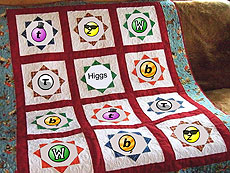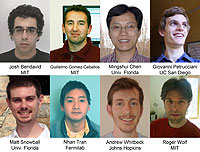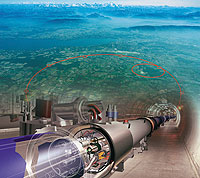The Higgs boson quilt
 |
Physicists stitched together the various pieces of analysis to yield a combined measurement. |
The search for the Higgs boson is the current flagship analysis for the CMS experiment. The Higgs boson is the missing bit of the Standard Model and finding out whether it exists or not will be a ringing endorsement of the LHC research program. The question should be resolved later this year.
While the data taken in 2011 was not enough to be the final word on the Higgs boson, it was enough to restrict its hiding places to a few narrow energy ranges. At the recent Moriond conference, CMS presented their Higgs result, which has been submitted for publication.
Searching for the Higgs boson is a tricky business. While we don't know if it exists, there are strict theoretical predictions about the myriad of possible decay patterns. While the Higgs boson would preferentially decay into the heaviest particles consistent with conserving energy, there is the possibility that it would decay into two massless photon. Although this rare decay would occur only about 0.1 percent of the time, the signature is obvious. Also, the detector is optimized to measure photons.
Once the analyses searching for various decay patterns are complete, they must be combined to give maximum impact. Given the amount of data now available, no single analysis is adequate to discover the Higgs boson. The combination begins to approach the sensitivity needed.
When the various signals were properly combined, CMS scientists didn't find the Higgs boson, but the collaboration was able to say that if it existed, it is most likely to be found in the range of 115-127 GeV. There was also a tantalizing hint at 124 GeV. Needless to say, this possible signal will receive extra scrutiny as the LHC starts to collide beams again in just a few days. It is highly likely that 2012 will be the year when the Higgs conundrum is resolved.
—Don Lincoln
 |
These analyzers contributed by combining together dozens of Higgs analyses, which involved the work of many hundred physicists.
|
 |
CMS made impressive progress in its studies of the Higgs boson's mass due to the exceptional performance by the LHC and the professionals who operate it. CMS thanks them for their pivotal contribution to all of our measurements. |
|